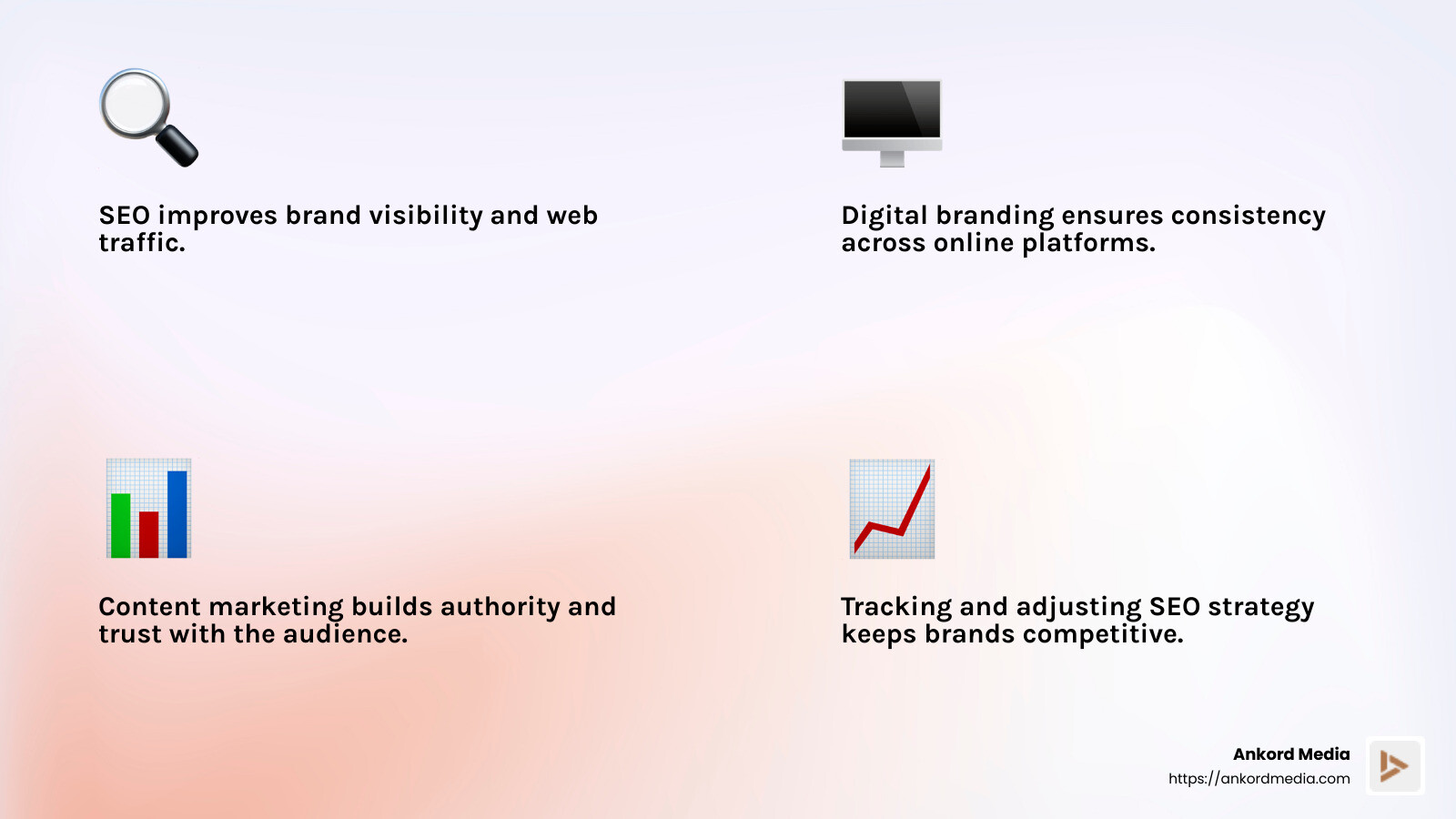
Brand strategy development is the blueprint for crafting a memorable and impactful brand. It's not just about having a catchy logo or a sleek website; it's about defining who you are, what you stand for, and how you want the world to see you. In today's competitive market, a strong brand strategy can make all the difference. This strategy helps ensure your brand resonates with your target audience and drives business growth.
Key elements of brand strategy development include:
- Defining your brand's mission and vision to guide decision-making.
- Creating a consistent brand identity that reflects your core values.
- Understanding your target audience to deliver messages that connect emotionally.
The world's biggest brands have mastered these elements, helping them to stand out in a crowded marketplace.
I am Milan Kordestani, a Gen Z entrepreneur and the founder of Ankord Media. With years of experience in digital design and branding, I've helped numerous businesses with their brand strategy development, aiming to make brands not just visible, but truly unforgettable.

Understanding Brand Strategy Development
A well-crafted brand strategy framework is the foundation for any successful brand. Think of it as the architecture that supports every aspect of your brand, from your visual identity to your communication style. This framework guides how you present your brand to the world, ensuring consistency and coherence at every touchpoint.
Brand Strategy Framework
At its core, a brand strategy framework involves defining your brand's mission, vision, and values. These elements act as guiding stars, helping you steer tough decisions and ensuring that your brand remains true to its core.
- Mission Statement: This defines your brand's purpose and the impact you aim to have on the world. It's more than just being the best or cheapest; it's about the deeper value you bring to your customers.
- Vision Statement: This sets the long-term direction for your brand, outlining what success looks like in the future. It helps align your team and guides strategic decisions.
- Brand Promise: This is your pledge to customers, encapsulated in a memorable tagline. It sets expectations and builds trust.
Brand Positioning
Brand positioning is about determining how you want your brand to be perceived in the marketplace. It involves identifying what makes your brand unique and why customers should choose you over competitors.
A strong positioning statement captures the essence of your brand and differentiates you from others. It should be grounded in reality and reflect both current strengths and future aspirations.
Consider the case of a technology consulting firm that initially struggled with a narrow market perception. By redefining their positioning, they expanded their brand's reach beyond just fundraising technology experts.
Brand Communication
Effective brand communication is key to making your brand strategy come alive. It's about translating your brand positioning into messages that resonate with your target audiences. Each audience might be interested in different aspects of your brand, so tailor your messages accordingly.
- Core Messages: These should be consistent across all audiences but can be customized to emphasize relevant points for each group.
- Messaging Strategy: Develop a messaging architecture that includes sample headlines, differentiators, and responses to common objections.
- Digital Presence: Your website and online content are crucial for brand communication. They not only inform but also engage and build trust with your audience.
Effective brand communication is not just about talking; it's about listening and engaging with your community. By understanding and addressing the needs and concerns of your audience, your brand becomes more relevant and impactful.
By building a solid brand strategy framework, positioning your brand effectively, and communicating consistently, you set the stage for brand success. Next, we'll explore the key components that make a brand strategy truly stand out.
Key Components of a Successful Brand Strategy
Creating a successful brand strategy involves several key components that work together to define who you are and how you connect with your audience. Let's break down three essential elements: brand values, brand identity, and brand personality.
Brand Values
Brand values are the beliefs and principles that guide your business decisions and actions. They form the moral compass of your brand, influencing everything from company culture to customer interactions.
- Why They Matter: Consumers today are more conscious of the brands they support. They want to align with companies that share their values. By clearly defining and communicating your brand values, you attract customers who resonate with your ethos.
- Example in Action: Drunk Elephant, a skincare brand, emphasizes transparency and safety in its products. Their commitment to using only clean ingredients has built trust and loyalty among their customer base.
Brand Identity
Your brand identity is the visual and tangible representation of your brand. It includes elements like your logo, color palette, typography, and design style.
- Visual Consistency: A consistent brand identity helps consumers recognize your brand instantly. Think of the golden arches of McDonald's or the swoosh of Nike. These are more than logos; they are symbols that evoke specific emotions and associations.
- Creating Your Identity: Start by understanding what emotions you want your brand to evoke. Use colors, fonts, and imagery that align with these emotions. A well-crafted brand identity supports your messaging and improves brand recall.

Brand Personality
Brand personality is the human-like traits associated with your brand. It answers the question: If your brand were a person, what would they be like?
- Defining Traits: Is your brand playful and witty or serious and professional? Your brand personality should align with your target audience's preferences and your industry norms.
- Connection Through Personality: A strong brand personality makes your brand relatable and memorable. Take Warby Parker, for instance. Their quirky and approachable personality is reflected in everything from their marketing campaigns to their customer service interactions.
- Crafting Your Personality: Consider what adjectives best describe your brand. Ensure these traits are evident in your communication, customer service, and even product design.
Bringing It All Together
A successful brand strategy seamlessly integrates brand values, identity, and personality. This integration ensures that every interaction with your brand is consistent and reinforces your core message. By aligning these components, you create a brand that stands out and resonates deeply with your audience.
Next, we'll dig into the practical steps you can take to develop a robust brand strategy.
Steps to Develop a Brand Strategy
Creating a brand strategy involves aligning your business strategy, understanding your target audience, and crafting effective brand messaging. Let's explore these steps in more detail.
Business Strategy Alignment
Your brand strategy should align with your overall business strategy. This ensures that every branding effort supports your broader business goals.
- Integration with Business Goals: Your brand should reflect your company's mission and vision. This alignment not only strengthens your brand but also ensures all departments work towards common objectives.
- Example: Consider a tech company with a mission centered on innovation. Their brand strategy might focus on cutting-edge design and forward-thinking messaging to reinforce this mission.
Understanding Your Target Audience
Knowing your target audience is crucial for developing a brand strategy that resonates.
- Research and Insights: Use data from surveys, customer feedback, and market research to understand your audience's needs, preferences, and pain points. This information will guide your brand messaging and positioning.
- Creating Personas: Develop customer personas to represent different segments of your audience. These personas help you tailor your brand messaging to meet specific needs and desires.
- Case Study: A company like Warby Parker effectively uses customer personas to guide their quirky and approachable brand personality, ensuring it appeals to their target market.
Brand Messaging
Brand messaging is how you communicate your brand's values and personality to your audience.
- Core Messages: Develop key messages that align with your brand's values and resonate with your target audience. These messages should be consistent across all platforms and touchpoints.
- Addressing Concerns: Anticipate common objections and prepare responses that reinforce your brand's strengths. This builds trust and credibility with your audience.
- Example of Messaging Strategy: A brand like Drunk Elephant emphasizes transparency and safety in its messaging, aligning with their brand values and building trust with customers.
By aligning your business strategy, understanding your target audience, and crafting compelling brand messaging, you can develop a robust brand strategy that stands out in the marketplace.
Next, we'll explore the role of technology in brand strategy development.
The Role of Technology in Brand Strategy Development
Technology is a game-changer in brand strategy development. It shapes how brands connect with audiences, drive engagement, and optimize their presence online. Let's explore how digital branding, content marketing, and SEO play crucial roles.
Digital Branding
Digital branding is about creating a strong online presence that reflects your brand's identity and values. It's not just about having a website or social media profiles—it's about how you use these platforms to tell your brand story.
- Consistency Across Platforms: Ensure your brand's visual identity and messaging are consistent across all digital platforms. This builds recognition and trust among your audience.
- Engagement: Use interactive tools like polls, quizzes, or live chats to engage with your audience. This not only boosts interaction but also provides valuable insights into customer preferences.
- Example: Crocs uses collaborations and limited-edition releases to maintain excitement and engagement across digital channels, reinforcing their brand identity.
Content Marketing
Content marketing is a powerful tool for building your brand's authority and connecting with your audience.
- Valuable Content: Create content that educates, entertains, or solves problems for your audience. This positions your brand as a helpful resource and builds trust.
- Diverse Formats: Use a mix of blog posts, videos, infographics, and podcasts to reach different segments of your audience. This keeps your content fresh and engaging.
- Case Study: Heller Consulting improved their brand perception by broadening their content strategy beyond fundraising technology, showcasing their wider expertise.
SEO (Search Engine Optimization)
SEO is essential for making your brand findable online. It involves optimizing your content and website to rank higher in search engine results.
- Keyword Strategy: Use relevant keywords that your target audience is searching for. This helps attract the right visitors to your site.
- Quality Content: Search engines prioritize content that is informative, relevant, and engaging. Focus on creating high-quality content that answers your audience's questions.
- Tracking and Adjusting: Regularly track your website's performance and adjust your SEO strategy as needed. This ensures your brand stays visible and competitive.

Technology, through digital branding, content marketing, and SEO, empowers brands to reach and engage their audiences effectively. By leveraging these tools, you can lift your brand strategy and drive meaningful connections with your customers.
Next, we'll address some frequently asked questions about brand strategy development.
Frequently Asked Questions about Brand Strategy Development
What is brand strategy and development?
Brand strategy is a long-term plan designed to achieve specific goals that result in the identification and preference of your brand by consumers. It defines what your brand stands for, its core values, and how it communicates with the world. It's the blueprint for how a brand will be perceived in the market.
Brand development is the process of strengthening your brand. It involves enhancing brand awareness, increasing customer loyalty, and driving sales. This process is ongoing and evolves as the market and consumer preferences change.
What are the four types of branding strategies?
- Line Extension: This involves expanding an existing product line by adding new varieties, such as new flavors, colors, or sizes. It's a way to leverage the existing brand's reputation and customer base to introduce new products.
- Brand Extension: This strategy uses an established brand name to launch a new product in a different category. For example, a clothing brand might introduce a line of home goods. This helps in reaching new markets and diversifying offerings.
- New Brand Strategy: When a company creates a new brand to enter a market where it currently has no presence, it's employing a new brand strategy. This is often used to target a different audience or to enter a new product category.
- Flanker Brand Strategy: This involves creating a new brand to compete within the same category as the company's existing brands. The goal is to capture more market share by providing alternatives to consumers without cannibalizing existing products.
What are the 4 C's of brand strategy?
- Company: Understanding your own company's strengths, weaknesses, and core competencies is crucial. This helps in identifying what sets your brand apart and how you can leverage your unique capabilities.
- Category: Analyze the product category to understand the overall market dynamics, trends, and consumer behaviors. This helps in positioning your brand effectively within the market.
- Competitors: A thorough analysis of competitors is essential to identify their strengths and weaknesses. This insight helps in differentiating your brand and finding opportunities to stand out.
- Customers: Knowing your target customers—what they want, need, and value—enables you to tailor your brand strategy to meet their expectations and build a loyal customer base.
These elements of brand strategy development are foundational in crafting a brand that resonates with its target audience and stands out in the marketplace.
Next, we'll explore how Ankord Media applies strategic branding to foster authentic connections with its clients.
Conclusion
At Ankord Media, we believe that strategic branding is more than just creating a logo or a catchy tagline. It's about crafting meaningful experiences that resonate with audiences and transform bold ideas into tangible success. Our approach focuses on building authentic connections with our clients and their customers.
Your brand lives and breathes online. We specialize in utilizing cutting-edge technology and design to create impactful digital experiences. Our unique blend of strategic branding and storytelling ensures that every touchpoint with your brand is consistent and engaging.
Our mission is to partner with visionary clients who are not afraid to challenge the status quo. By understanding your brand's core values and aligning them with your business strategy, we help you steer the complexities of the market and connect with your audience on a deeper level.
Through our strategic branding services, we aim to amplify your brand's voice and accelerate your business growth. We measure our success by how effectively we translate your innovative ideas into reality, ensuring your brand stands out in a crowded marketplace.
Brand strategy development is about crafting a narrative that not only captures attention but also fosters long-lasting relationships. At Ankord Media, we are committed to helping you achieve this by turning your brand vision into a compelling story that resonates with your target audience.


